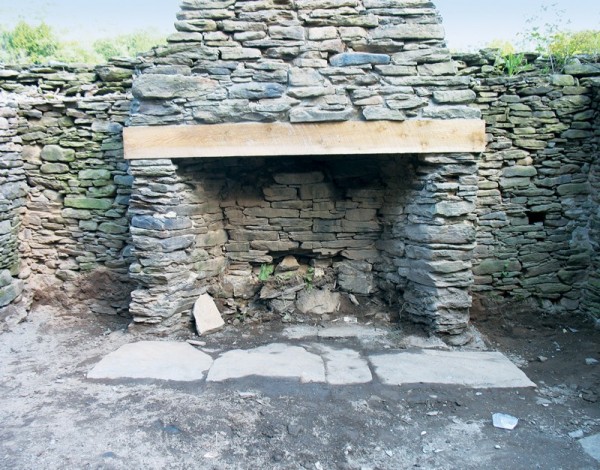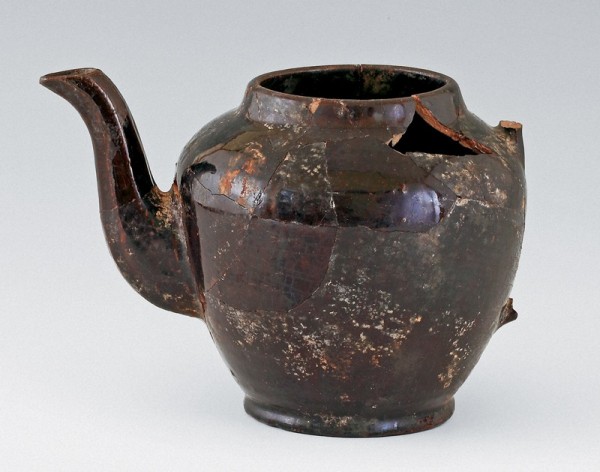
The original fireplace, hearth, and walls of the ca. 1820 Cowan stone house in Delaware County, New York. (Photo, Anthony Butera Jr.) It is believed that the house burned ca. 1900. The teapot was found buried on the right side of the hearth when a temporary support was built in order to replace the rotting lintel. It was probably sitting on a shelf that was supported by the chimney cheek and the adjacent wall. Charred wooden supports are still in place.

Teapot, Thomas Crafts, Whately, Massachusetts, ca. 1821–1833. H. 5 1/2". (Photo, Robert Hunter.) This vessel was found on the right side of the hearth illustrated in fig. 1. A lid from a Thomas Crafts teapot in the author’s collection fits this example perfectly.
During restoration of a circa 1820 stone house in rural New York State, an earthenware teapot, likely made at the circa 1821–1833 Thomas Crafts teapot factory in Whately, Massachusetts, was discovered buried next to the hearth (fig. 1).[1] The house was situated in Delaware County, a remote area of the western Catskills that was settled in the late eighteenth and early nineteenth centuries. Andrew and Helen Cowan and an unknown number of children emigrated from Selkirk, Scotland, in 1820 and built this house.[2] Ceramic sherds recovered from the site’s surface are typical of the era. These include a variety of dipped wares, shell-edged earthenwares, painted and printed pearlwares, and American stoneware. A small amount of American red earthenware was also found.[3]
Based on its brilliant metallic black glaze and resemblance to extant examples, the teapot (fig. 2) has been attributed to the Thomas Crafts factory.[4] Its faceted eight-sided spout relates to a faceted eight-sided spout sherd found in the culvert of the house next to the Cowan house, and matching spouts have been recovered recently from the Crafts manufactory site.[5] The thick glaze on each example makes it difficult to determine how the spout was formed. In 1832 Crafts reported that he made 2,080 dozen teapots annually and sold them for one dollar per dozen.[6] Since the market was being flooded with these cheap teapots, it is not surprising to find evidence of two of his teapots in this remote location.
There are probably fewer than two dozen extant examples of Thomas Crafts teapots, making this specimen quite important. The original owners would be surprised to see this modest, everyday object to be of such interest to future generations.
ACKNOWLEDGMENTS
I extend thanks to Ralph Cowan, David Graci, and Shiela Kohler from the Pocumtuck Memorial Association, and especially to Diana and Garry Stradling for their enthusiastic encouragement.
Anthony Butera Jr., 112 Tuthill Street, Port Jefferson, New York 11777
erawder@optonline.net
Brian Cullity, ed., Slipped and Glazed: Regional American Redware, exh. cat. (Sandwich, Mass.: Heritage Plantation of Sandwich, 1991), p. 29.
Andrew Cowan’s great-grandnephew Ralph Cowan, who still resides in Delaware County, provided this information; personal communication, August 2009 and November 2010.
History of Delaware County, N.Y. (New York: W. W. Munsell & Co., 1880), p. 53, which offers an account of what was brought by the county’s settlers: “. . . some cups and saucers, and a few plates, all of the ‘shell-edged’ variety, now nearly out of existence. . . .”
Lura Woodside Watkins, Early New England Potters and Their Wares (Cambridge, Mass.: Harvard University Press, 1950), p. 104. Watkins describes the teapots as “of common redware with a remarkably brilliant, almost metallic glaze.” Diana and J. Garrison Stradling (personal communication) gave the teapot an attribution to Whately, Massachusetts, in January 2010.
David Graci, an advocational archaeologist, has recovered matching spouts and other types of spouts from the Crafts pottery site. A visit to his house in October 2010 provided the identification of these vessels.
Watkins, Early New England Potters, p. 104.
